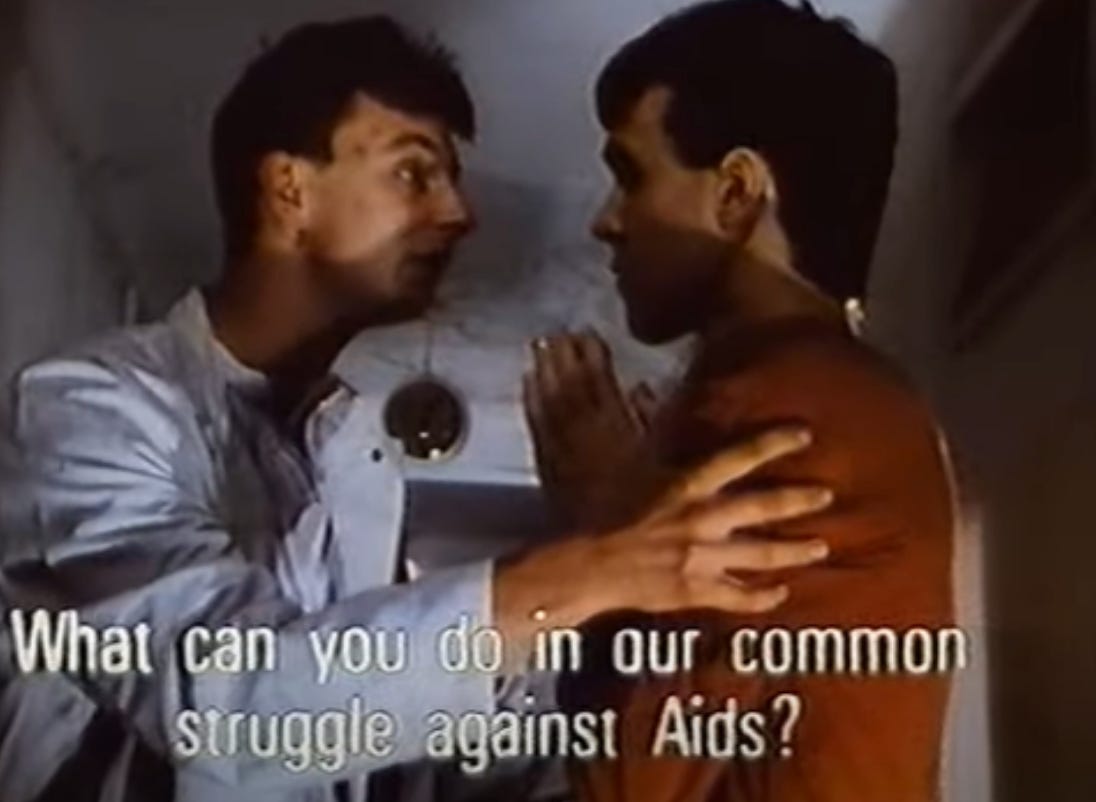Sometimes it’s not the great movies of an era that give us the truth about that era. Sometimes it’s the shitty movies. The low-budget, made-on-a-dime, stitched-together poorly lit films that provide us with the understanding we want and need when thinking about an especially historic moment in time.
The AIDS epidemic was shown to us visually. Even before anyone knew (or, in the case of straight audiences, cared to know) what the hell was going on, first with GRIDS, then with AIDS, people were making angry movies about it. And the anger in such films is righteous: it leaps off the screen. It is in its way intoxicating. What could we get done today, you have to ask yourself, if we had recourse to such anger? What kind of mountains could such anger move around, for instance, the COVID-19 pandemic, which is very much still ongoing and is, unlike AIDS, conspicuously un-visual. You might even call it anti-visual.
We haven’t had our great COVID movie yet (thank god) because an inability to make movies on a large scale is one of the continuing features of the pandemic itself.
In 1986, we didn’t have great AIDS movies either. The world was still in a state of denial about the virus, in denial about gay identity itself. The suffering needed to be visualized: it was coming from a community so long forced to remain unseen, unheard, without any witnesses who cared to extend their empathy into world still feared by the straight populace. So the art of the time, naturally, was aggressive. It was combative. It was dramatic, campy, over the top. And if you want a perfect example of this, look no further than A Virus Knows No Morals, a German film from 1986 that feels less like a film and more like a collage of current events, a kind of visual temperature-taking during a moment when queer people were sick of getting sick, and sick of being ignored.


The paranoia, mixed messages, and terrified attitudes are familiar to us from more whitewashed, middle-of-the-road fare like Philadelphia or Rent. But this movie is telling the story of AIDS without using any kind of narrative conventions. It’s an impressionist film about AIDS, one which reminded me of my other favorite experimental AIDS film I saw last year, the fantastic Zero Patience. That movie—another vatic, narrativeless experience—moves beyond sheer panic eventually and into more interesting emotional territory. Though the difference between a film like Virus and a film like Patience could be chalked up to the 6 years between them. In 1986, AIDS was still something straight people wanted to shove under the rug. By 1991, it had made its mark on the culture.

But it was films like this—weird, not especially comfortable to watch—that helped get us there.
When we look back on this pandemic, what will we see to make the 3 or 4-year period of shutdown, fear, and death make sense to us? Not a major motion picture, I think, but a million memes, TikToks, and saved IG lives that will remind us not how it looked or sounded or actually was, but how it felt. And that’s the thing we’ll want to remember above all, how it felt. The very thing that we’re trying so hard these days to forget.♦
Help make sure LGBTQ+ stories are being told...
We can't rely on mainstream media to tell our stories. That's why we don't lock our articles behind a paywall. Will you support our mission with a contribution today?
Cancel anytime · Proudly LGBTQ+ owned and operated
Read More in Entertainment
The Latest on INTO
Subscribe to get a twice-weekly dose of queer news, updates, and insights from the INTO team.
in Your Inbox














